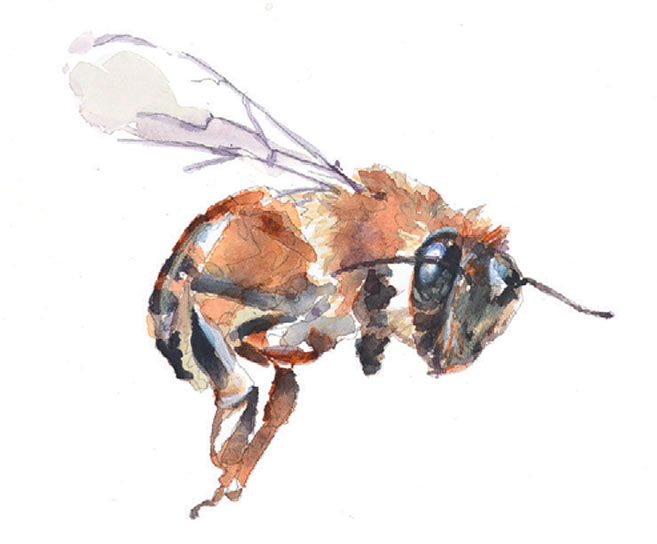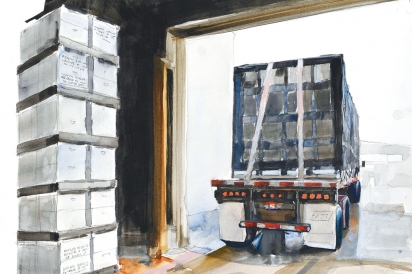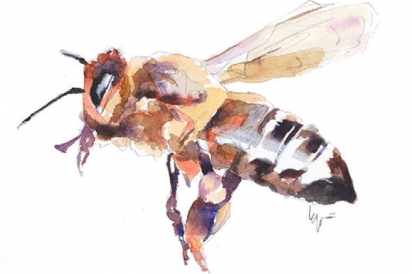Bringing Bees to the Trees
It’s almost pitch dark in the giant cement building that holds around 1.2 billion honeybees outside of Burley. The 20,000 hives are stacked a dozen high, but there is no buzzing. The air is calm and quiet. A few streams of golden light come from two forklifts and the running lights of an 18-wheel semi truck waiting to load up to 500 of the hives on the empty flatbed.
The truck driver and a handful of beekeepers work by headlamp, careful not to let the honeybees see too much light. The bees have been kept in darkness and held at around 43°F for two months. As soon as they see the light, they’ll become active—a deadly mistake.
The dirt floor is carpeted in a layer of dead bees; bees that grew restless in their hives and stretched their wings, died of old age or got sick and pushed out by their own colony. The cold killed others. But for every dead bee lying on the ground, there are thousands of live ones safely inside their hives, docile.
“Idaho is the number one state for overwintering bees in buildings,” said Gary Belliston, co-owner of Belliston Brothers Apiaries.
Gary and his cousin, Albert, took over the business from their fathers, who started it in 1948. They keep a few thousand of their own bee hives and charge $8 per hive to store bees over winter. The hives come in from Texas, North Dakota and several states around the Midwest.
Once the end of January hits, Gary opens the giant doors to the storage building just long enough to let a huge truck pull in. Even a full-sized semi looks small in the large, dark room. It takes just over an hour to load 400–500 beehives on the truck, secure them with thick straps and cast a large green net over the whole shipment, keeping the bees contained should they decide to leave their hives.
Nearly 50 semis will come and go through this storage unit over two weeks, collecting the hives and heading south. It takes 14 hours to get to California, where the hives are placed near the almond orchards and the bees get to work pollinating the almond trees. Or, as Gary calls them, “ammon trees.”
“California doesn’t have near enough native bees,” Gary explained. “The bees come from as far away as Florida and all over the United States.”
John Miller of Miller Honey Farms in Blackfoot sent 12,000 of his hives to California this year. Miller’s family has owned the honey farm for 122 years, and they’ve transported bees to California for nearly a century. He said his great-grandfather was one of the first beekeepers to do it.
“It’s a lot safer now than it was 100 years ago by railcar,” Miller said.
According to Miller, California farmers started relying heavily on beekeepers from all over the country in the early 1980s.
“The demand for hives to provide pollination exceeded the supply of beehives in California. Almond acreage has quadrupled,” Miller said. “Today, with the demand for bee-pollinated crops, it’s like moving all the cows in America to California for a couple of months.”
Just like cows, the beehives need cowboys. And as bees become more valuable, Miller says his hives need to be protected.
“I’ve got 16 guys in California right now,” Miller said. “We hire private security to make sure those bees stay in the farmers’ fields.”
Gary Belliston said the value of bees continues to increase as the farmers need more and the beekeepers have less.
“The demand for bees is very high by the almond growers, especially over the last several years because there have been a lot of maladies that have hit the beekeeping industry,” Gary said. “The hive numbers are down and this year it’s particularly difficult for the almond growers to find enough bees to pollinate for them.”
Gary and Albert had 5,400 hives at their high point last year. But last fall, they lost 40% of their bees to Colony Collapse Disorder, a blanket term used to describe a swarm of conditions that have caused bees to die off in large numbers. In a normal year, they’d only lose around 10%.
“It’s difficult to get through,” Gary said. “The bees have just disappeared from their hives, or they’re sick—you can tell. You spend your whole year trying to build healthy, good hives then you have that happen.”
Gary can’t pinpoint exactly what’s causing his bees’ demise. He says the Varroa destructor—a parasitic mite that attacks bees, especially in weak colonies—is a factor. He also believes the disorder could have some sort of underlying cyclical cause.
According to the USDA’s Agricultural Research Service, transporting bees to pollinate crops could also be making them more susceptible to Colony Collapse Disorder, because it confines the bees and increases contact of colonies from different hives, which in turn increases the transmission of pathogens.
It’s something beekeepers across the country are struggling with. According to Bee Informed—a partnership supported by the USDA and the National Institute of Food and Agriculture, American beekeepers lost 42.1% of their colonies from April 2014 to April 2015. In Idaho, beekeepers lost around 33%.
“We’ve learned to pay rigorous attention to hive health,” Miller said. “This year, it looks like we had a 12–15% loss, but I had a guy call me earlier today who lost 90% of his bees. He’s going out of business.”
Back in Burley, Gary spends his days leading up to the big haul combing through his hives, making sure he’s sending bees that are strong enough to make it to California and pollinate the orchards. When a hive looks weak or sparse, he dumps the remaining bees into a bin, where they don’t live long.
“Some of the things we used to complain about and wish we didn’t have to deal with, we’d give anything to have those problems again over this,” Gary said.
Rather than keeping the bees in holding fields in California or other warm states, it’s cheaper for beekeepers to send their bees to be stored with Belliston Brothers. The cold and darkness make the bees go into a kind of hibernation that keeps them from consuming more honey and needing to be fed.
Honeybee hives happen to be Kevin Rathbun’s favorite thing to haul on his semi-truck. The Twin Falls native has been transporting and working with honeybees for 30 years.
“It’s Mother Nature,” Rathbun said. “The rest of the time, I’m hauling fertilizer, feed, tack. Even marble from the coast back—whatever we can get. Then, we get to run bees. Mother Nature is the best thing you can run.”
It’s also one of the more challenging shipments Rathbun takes on. Because the bees become active during the daytime, Rathbun has to keep his truck wheels spinning while it’s light out. That keeps the air too cold for the bees to come out of their hives.
“You gas up at night and you gas up first thing in the morning. Other than that, you cannot stop,” Rathbun said. “You gotta love drivin’.”
Idaho’s close proximity to California makes the state an even more appealing place for beekeepers to store their bees, because it’s only a day-long drive. Gary said just about all the bees make the drive to California alive. Then, once summer is in full swing, their hive numbers swell.
The Belliston bees spend most of their summers in Merced, California, near the San Joaquin Valley and Bakersfield. Gary isn’t sad or sentimental to see them go.
“I want them down in California making money,” he said.
After his bees leave to pollinate the almond orchards, Gary will take three weeks off to travel to Africa and install water filters in underdeveloped areas. After that, he’ll make his way to California and tend his hives once again.
Gary said he’s surprised his life has been devoted to beekeeping. He grew up helping his dad with the bee business, then moved to Boise to attend college at Boise State University. He worked for a beekeeper in Nampa through college to afford his tuition.
“When I left Burley, [working with bees] was the last thing in the world I ever wanted to do,” he said. “But between college, growing up and maturing, that’s when I just grew to love it. I moved back to Burley and my partner and I took over our dads’ business. My degree is in English. I can quote poetry and Shakespeare to my bees.”
Gary’s son, now in his 30s, also works for a beekeeper in the Nampa area, running close to 12,000 hives.
After the truck leaves the storage unit unceremoniously, Gary gently pulls a bee off his honey-stained white bee suit and talks about his work. He rarely wears the mesh hood attached to his suit and in the summertime, he doesn’t wear a shirt at all. He suffers only a handful of bee stings in the winter, but it’s a fact of life in the summer.
“I’ll take a few stings just because, to me, it’s worth it. They all hurt. Anyone who ever says they don’t hurt is lying to you,” he said, sitting in his pickup truck on a rainy, cold and muddy morning in late January.
“The only good thing about this Colony Collapse Disorder is the heightened awareness it’s brought among the public about the health of bees,” he said. “It’s not just about having honey. It’s about the pollination they do. Without bees, there are no almonds. Without bees, there is no us.”







